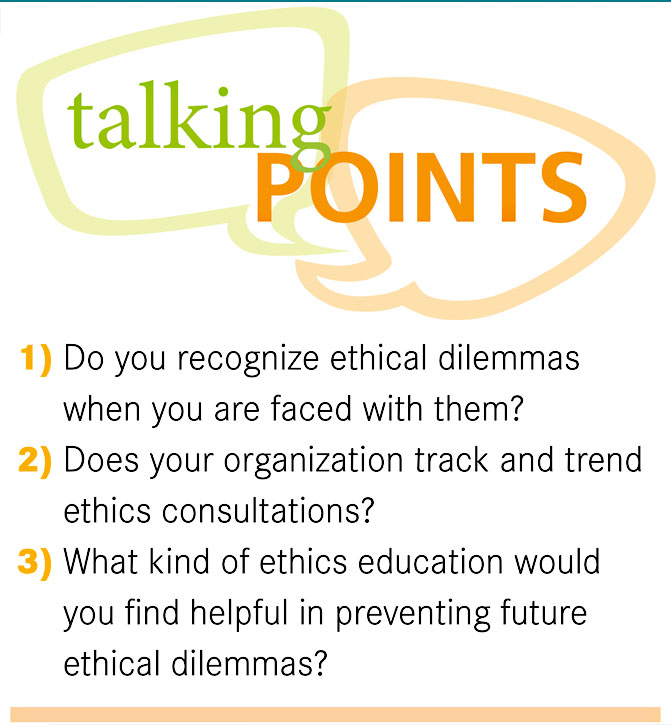Through ethics quality and learning
By Joan Cody
Many of you will have come to know about ethics because of a case you have been involved in or heard about. There have been many sensational cases, some of which have helped to shape the face of health care philosophically, medically and legally. Cases like Roe vs. Wade, that made abortion rights a dinnertime conversation, while the Philadelphia head-injury study on primates made everyone think differently about scientific merit. The tragic situations of Karen Ann Quinlan and Nancy Cruzan had families, hospitals and lawyers see their personal and legal battles play out on the nightly news as we tried to reconcile our feelings and find a balance between medical futility and the cost of health care. Dolly the cloned sheep had many thinking science had gone a little too far, while Canada’s recent landmark Supreme Court decision on Carter vs. Canada, which established that the “sanctity of life” also includes the “passage into death,” has had others wondering if science will go far enough come February 2016, when the ruling comes into affect.
These cases have made history. They are markers of the evolution, growth and learning of modern bioethics. With each case philosophers, bioethicists, health care providers and leaders have contemplated the relevant morals—beneficence, respect for autonomy, fidelity, justice, duty, integrity, non-maleficence and compassion, to name a few. The effect of those considerations on us as citizens is powerful.
Day-to-day decisions
Patients, clients, families and health care providers face dilemmas on a daily basis. They might not rival those of remark described above, but nonetheless challenge us day to day. Residents, clients and families can all tell stories about making decisions around issues such as consent, end-of-life choices and the right to live at risk. Health care teams, who engage in increasingly complex roles, face dilemmas in care planning for residents with responsive or aggressive behaviours and those with severe pain, and with respect to managing care within our economic bounds.
Complicating it all is the fact that it is not always easy to see when there is an ethical dilemma, especially when you are in the middle of it. Sometimes it can just feel like a problem that just needs a ready solution. Should the falling resident be restrained in bed? How will you manage the aggressive resident threatening others in the dining room? How will you advocate for the resident who is still in pain when his family feels he has had enough morphine this evening? Do you have a plan for the patient who insists on being independent in personal care, but continues to sustain skin tears from banging her hands on the bathroom door?
Sharing experiences
Thinking about these kinds of dilemmas in advance, as a collection of cases, will help to be better prepared. Of course we all learn from our own experience but, in the gathering of similar cases, we have the opportunity to share experiences and considerations that will lead to more positive outcomes— and hopefully less moral distress at the bedside. To do this, we need to track and trend the day- to- day cases in our facilities and our organizations. Finding out what our common dilemmas are provides an opportunity to have shared learning about bioethics. It will help us to explore social and cultural norms, seeing both the bigger picture as well as any that may be very local. It will give us the opportunity to hear and ask about organizational concerns and provide learning on how to manage solutions using critical-thinking skills without restricting things like choice and compassion. Those making policy solutions will have a greater opportunity to have practical application if they are part of this common experience.
Some cases are a lot harder than others, and that is when we try to facilitate ethics consults. Maybe it’s just a quick “hall talk” to ensure everyone is on the same page, or a full consultation so that we can obtain enough information for a deeper understanding of the issues. Either way, how we choose to learn and move forward is important if our goal is to deliver considerations that are of high ethical quality and helpful to everyone involved.
Sharing is critical and vital in developing an ethics culture within our homes, and increasing our ability to track and trend consultations with an eye for education. But we must also acknowledge good
ethical leadership is more than just a lack of dilemmas. Good stewardship requires us to attend to the quality of our ethics services. If we get an order for sedation for the aggressive resident
who is threatening to throw a chair through the window and thus prevent him from harming himself or others—but fail to acknowledge as we move forward in his care that turning leaves and frost warnings have created panic in his mind as he remembers past harvests and crops in the field—then the care of that resident lacks ethical quality.
Building ethics capacity
Our ability to offer ethical prevention as well as crisis intervention is key when committing to quality. Health care leaders have a responsibility in the building of ethics capacity for reflective thought and consideration, with as much importance attached to it as they have to things like resident safety and infection-control risk mitigation.
It is the accumulation of our experiences through activities such as ethics services data collection that we will find common themes and chances to share lessons learned, experience gained and knowledge found. This will help us to address the day-to-day dilemmas and ensure that the ethics services that we provide measure up to the quality and values that we trust and stand for.
Joan Cody, RN, is ethics practice leader at Extendicare (Canada) Inc.













